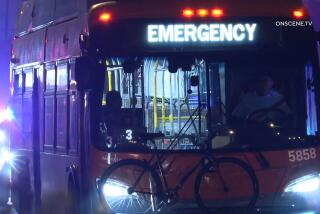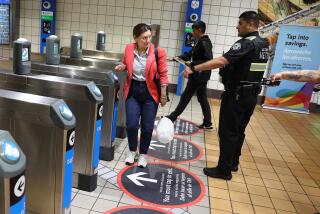Ad Nauseam : Is Nothing Sacred? Apparently Not, Judging by Ads in N. Y. Subways
- Share via
NEW YORK — Anal warts? Fissures? Hemorrhoids? Call 1-800-MD TUSCH
--Advertisement in New York subway trains
As every New Yorker knows, there is one cardinal rule of subway conduct: Never make eye contact with strangers. The rider standing next to you could be the next Bernie Goetz, a crackhead with lice or some wacko in Lederhosen running for mayor.
Better to mind your own business and read a newspaper, if you’re lucky enough to grab a seat or some elbow room. But if that fails, relief is just inches away in the colorful subway ads plastered inside each car. At the very least, they make the time go by.
Years ago, subway blurbs featured testimonials from Smokey Bear and steaming bowls of Nestle’s soup. Placards for chewing gum, Broadway shows and the Miss Subways contest--a beauty competition judged by passengers--filled the cars and helped speed riders along their way.
But those ads have vanished along with the nickel fare. Today, straphangers squeezed into rush-hour trains gaze at a jarring collection of public service announcements and bizarre medical promotions. They run the gamut from AIDS, unwanted pregnancy, rape and infant mortality to cures for bunions, calluses and corns.
The words of podiatrists are written on the subway walls--and the estimated 3.5 million people who ride the subway every day find them hard to ignore.
Few would deny the importance of messages about child abuse, sexually transmitted diseases and fetal alcohol syndrome in a city reeling from such problems; indeed, they educate people and reflect the deepening sense of crisis that many New Yorkers feel. But the sheer number of such blurbs, with little in the way of contrast or relief, has begun to grate.
“When you’re jammed in a car at rush hour and somebody’s nose is in your ear, what are you gonna do, share a moment?” asks subway patron Nick Revere. “I mean, they’ve got you, you’re a captive audience. All you can do is look at those damned ads.”
“Who Cares If You’ve Been Battered?” shouts one blurb, showing the somber face of a woman with a black eye. “Who Cares If You’ve Been Mugged?” asks the city’s victim’s assistance program. “Call Us When You’re Ready to Get Off Your High Horse,” says another ad, with a hypodermic needle plunging into a junkie’s arm. “Pregnant? Call Us,” reads an announcement that can be found on many of the subway’s 6,000 cars.
Medical clinics gobble up much of the ad space, offering relief for everything from hammertoes and measles to acne and rotting teeth. During the summer, ads for cockroach killers are also widespread. In one placard, a boastful cockroach writes an open letter to New Yorkers before succumbing to poison and dropping off the page.
Some blurbs even tell a story in two or three parts. In episode one of “The Decision,” a message from the AIDS hot line, hot-tempered Julio breaks off an embrace with his girlfriend, Marisol, when she demands that he use a condom. In part two, he learns that a lot of his friends have died of AIDS. Will Julio change his ways? Stay tuned for part three, in English and Spanish.
“There’s no question that the ads we have today are more depressing and downbeat than the ones we used to have in the past, from 40 and 50 years ago,” says Clifton Hood, a subway historian and archivist at La Guardia Community College in Long Island City. “But they’re important public service messages for people to digest. They reflect what’s happened to the city with social problems, and to the subway system itself over time.”
They’ve also become an irritant to some longtime riders. In a recent letter to the New York Times, Barbara Marin, a retired schoolteacher, said enough is enough.
“Can’t something be done to change the unrelentingly downbeat messages on display?” she complained. “Sure, people have problems, but one gets the impression that most of our fellow passengers are addicted, abused, diseased wretches living in roach-infested apartments.”
Only a few decades ago, the New York subway was a very different place.
On Dec. 23, 1946, the 231-mile network served 8.8 million passengers, a record unequaled by any other transit system, says Hood. More than 2 billion people rode the rails that year, and the subway ads they gazed at featured New York Yankee stars, the YMCA, appeals to charity and patriotic rallies in Central Park.
Many of these ads are preserved in the city’s transit museum, where visitors can wander through subway cars from 50 years ago. Fading but still attractive, the old placards feature steaming bowls of tomato soup and appeals by winking mermaids to visit Coney Island. There were ads for Manischewitz Gefilte Fish and Chateau Wine, which sold for 88 cents a quart.
“Hadassah says, Thank You America,” read one subway poster. “They came, They saw, They bought,” read another, in which housewife Bella Cohen touted the back-yard sale she had advertised in the now-defunct Brooklyn Eagle. If there was any hint of dark days to come, it came in the form of a stern message from then-Mayor Robert Wagner Sr. that housing discrimination was illegal.
“I really do miss the older ads,” says Barbara Gallagher, a Queens resident who has been riding the system for 34 years. “The most risque thing I remember reading on the train was an ad in which a conductor shouted: ‘Will all the men in this train please change to Reese’s Underwear?!’ ”
The subway’s golden era ended in the 1950s, when crime began plaguing the system, Hood says. Suddenly, New Yorkers began to worry about getting mugged and assaulted when they descended into the underground. In later years, graffiti made its appearance, with street artists and gang members spray-painting their messages on passenger cars.
In the years after World War II, vast numbers of riders who moved to the suburbs stopped using the subway. Soon the system began to show its age; trains broke down or derailed more frequently and lights failed inside the cars.
City officials attacked these problems with some success: Today, the trains run more promptly and the graffiti are all but gone. But the system has lost more than a billion annual riders since 1946, the fare has jumped to $1.15, and crime remains a huge problem.
In 1980, for example, there were 12,907 felony crimes reported in the subway: 20 homicides, 24 rapes, 5,009 robberies, 6,416 grand larcenies, 562 assaults, 238 burglaries and 638 other kinds of crimes. Ten years later, the number had swelled to 18,324 reported crimes.
These changes have had an impact on the advertisements placed in New York subways, says Tito Davila, a spokesman for the Metropolitan Transit Authority, which runs the system. There’s a misperception among advertisers that middle-income people avoid the trains, and this perpetuates the image of subways as a haven for panhandlers, criminals and the poor, he says.
“You can see it in the ads that are running today. There are a great many social problems we have, and the ads reflect that reality,” Davila says. “But there aren’t a lot of ads targeting affluent people who use the subways in large numbers. It’s very strange.”
According to Davila, a 1988 survey of New York subway riders showed that 39% earn $25,000 to $50,000 annually and only 10% earn less than $15,000. The ridership breaks down to 53% white, 26% black, 16% Latino and 5% Asian, figures that mirror the city’s racial makeup.
There’s a huge subway market waiting to be tapped, but advertisers have been slow to take the bait, says Joan Davidson, a spokeswoman for Gannett Transit, which pays the city $7 million annually for the right to sell and place advertisements in subway cars.
“People have a mistaken impression about the subways,” she says. “It’s an obstacle we’re constantly trying to overcome, to bring more of an advertising mix into the system.”
Meanwhile, the cars are filled with messages from Dr. Tusch, drug addiction specialists and bankruptcy counselors. The only happy people in subway ads, it seems, are laughing, kissing and getting lung cancer. Once you get past the cigarette ads, it’s a jungle out there.
Subway rider Marin, who hopes that other New Yorkers begin to speak out about the problem, says she has explored ways to cope with the downbeat blurbs. During one ride, when she became depressed by the photograph of a battered woman, Marin switched sides in the passenger car, only to gaze at ads for foot warts, abortion counseling and hemorrhoids.
“If you watched television for 24 hours and there were nothing but ads about headaches and bad breath, you’d tune out real quick,” Marin says. “In the subways, you can’t tune out until you get off. It’s just not what it used to be.”
Yet some things never change. Archivist Hood notes that some of the earliest ads to run on the New York subways implored riders to be more courteous to one another. Today, there are similar messages urging passengers to give up seats for the elderly or infirm.
Then and now, however, the message has had trouble getting through.
In his book “Under the Sidewalks of New York,” historian Brian Cudahy notes that the first record of a New York subway rider giving up his seat to a woman took place the day the system opened, in 1904.
The customer, F.B. Shipley, was from Philadelphia.
More to Read
Sign up for Essential California
The most important California stories and recommendations in your inbox every morning.
You may occasionally receive promotional content from the Los Angeles Times.










